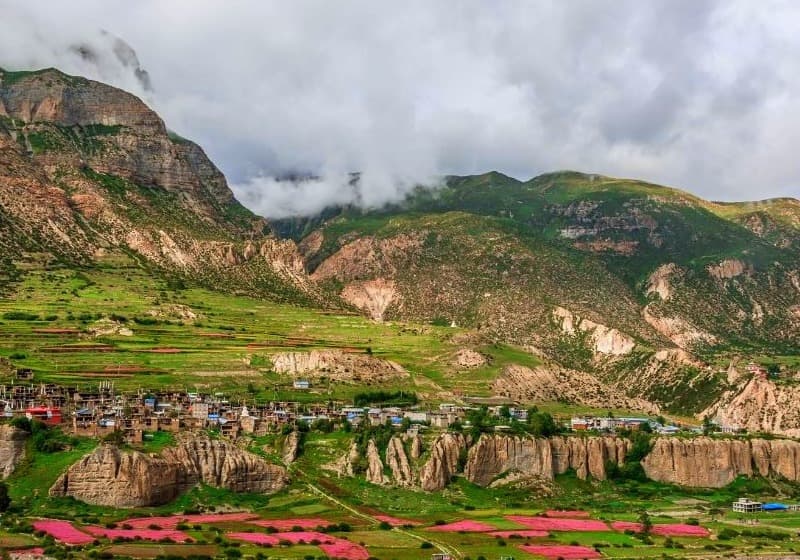Ghorepani Poon Hill Trek is renowned not only for its breathtaking vistas of the Annapurna and Dhaulagiri mountain ranges but also for its relative safety compared to other high-altitude treks in Nepal. Nestled within the scenic Annapurna region, this trek provides adventurers with a glimpse of Nepal's natural beauty without pushing them into the extremities of high-altitude trekking.
One of the primary reasons for its reputation as a safer trek is its altitude. Peaking at 3,210 meters at Poon Hill, the trek stays below the typical altitude where severe altitude sickness becomes a concern. This is particularly beneficial for novice trekkers or those who might be concerned about the health challenges associated with higher elevations.
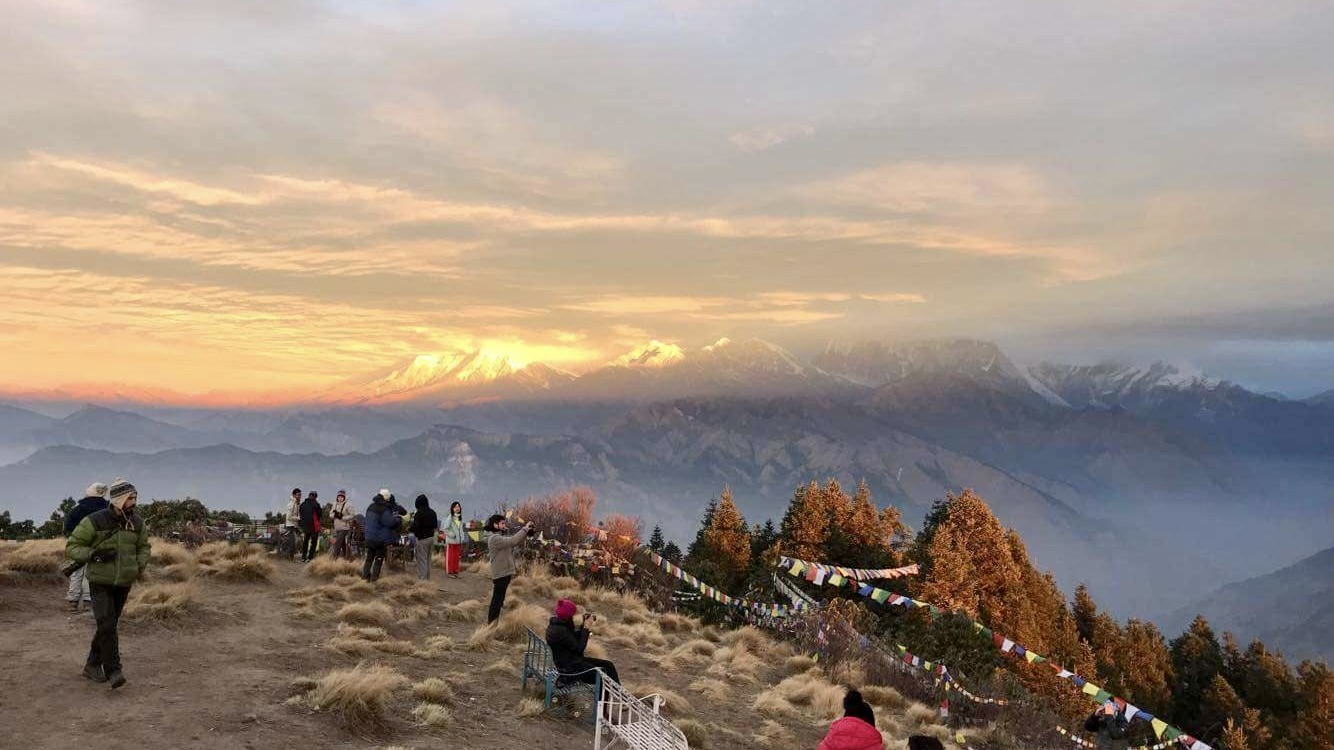
The trek's pathways are well-established and frequented by both locals and tourists alike. This ensures that the trails are maintained and that help if needed, is never too far away. The route weaves through several villages, where local amenities and accommodations in the form of teahouses are available, providing trekkers with regular points of rest and shelter.
Ghorepani Poonhill Trek stands out as a favorable option for those seeking a moderately challenging trekking experience in Nepal without the associated risks of higher altitude excursions. Its combination of stunning landscapes, established trails, and lower altitude makes it a safe and rewarding adventure for trekkers of all levels.
Altitude Sickness and Acclimatization
The allure of the Himalayas is undeniable, with treks like the Ghorepani Poonhill offering a mesmerizing blend of natural beauty and cultural immersion. However, trekking in high-altitude regions often brings up concerns about altitude sickness, a condition that can afflict those who ascend too rapidly to great heights. Understanding altitude sickness and the importance of acclimatization is vital for a safe and enjoyable trekking experience.
Altitude Sickness
- Altitude sickness, also known as Acute Mountain Sickness (AMS), is a concern for many trekkers embarking on high-altitude adventures. As one ascends to higher altitudes, the air pressure drops and less oxygen becomes available, which can pose challenges for the body. Symptoms might range from mild ailments such as headaches, dizziness, and fatigue to more severe conditions like High Altitude Pulmonary Edema (HAPE) or High Altitude Cerebral Edema (HACE), both of which require immediate medical attention.
Ghorepani Poonhill Trek and Altitude Concerns
- The Ghorepani Poonhill Trek, however, presents a lower risk of altitude sickness when compared to other Himalayan treks. Its highest point, Poon Hill, stands at an elevation of 3,210 meters. This is below the typical 3,500-meter threshold where altitude sickness symptoms are commonly reported. Therefore, while it's essential to remain vigilant and monitor any symptoms, the risk of severe AMS is considerably diminished on this trek.
-
[block](25, 37)
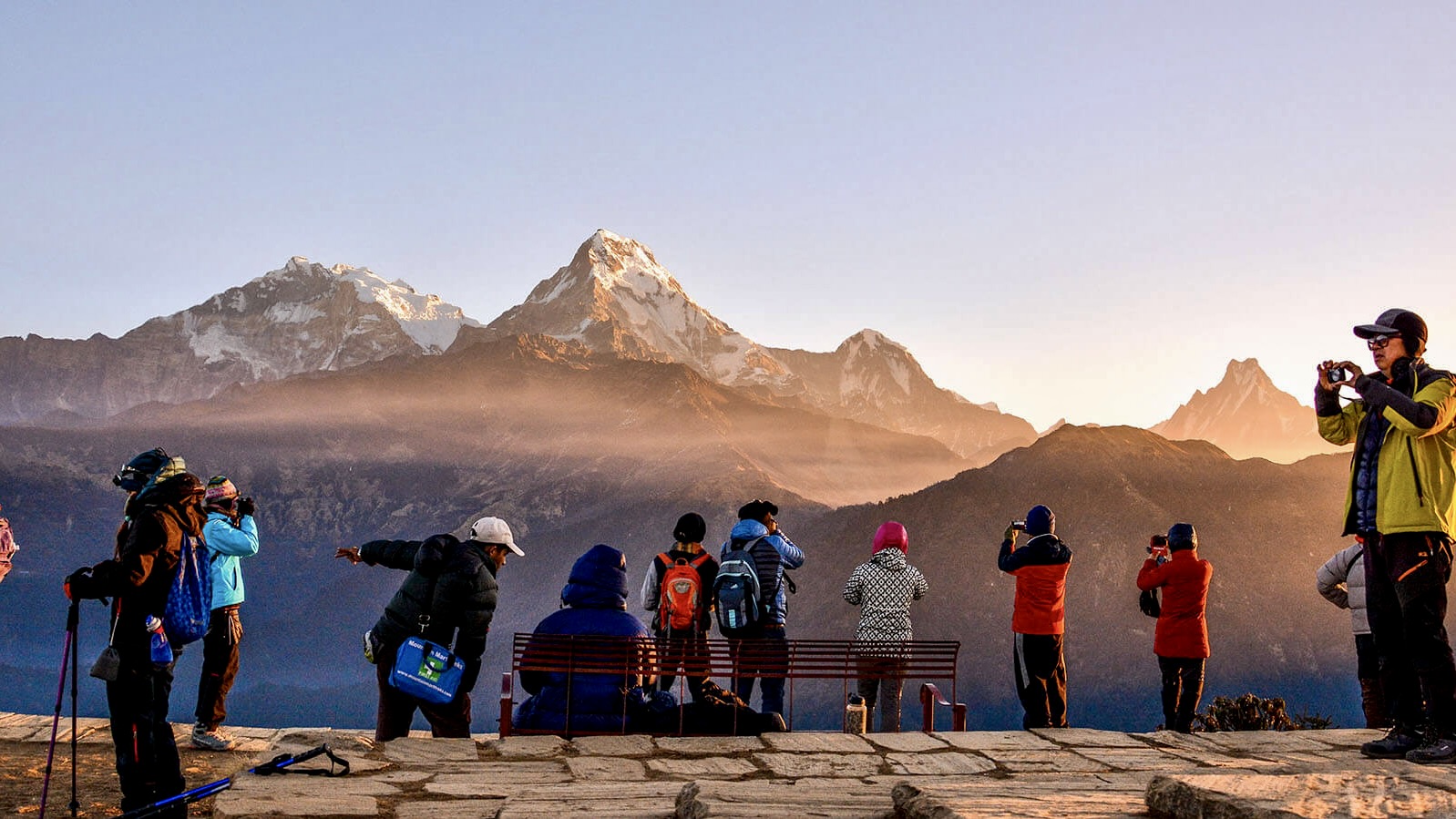
Acclimatization on the Trek
- While the Ghorepani Poonhill Trek does not ascend to extreme altitudes, understanding and practicing proper acclimatization is still beneficial. Given the trek's moderate elevation gain and its passage through various altitudes, the body naturally acclimatizes as one progresses along the route. The trek's design, which involves walking through diverse altitudes over a few days, allows trekkers' bodies to adjust gradually to the changing oxygen levels. This slow and steady ascent, combined with regular hydration and rest, works favorably in preventing AMS.
Preventive Measures and Recommendations
- Stay Hydrated: Drink plenty of water throughout the trek to aid in acclimatization.
- Know the Symptoms: Familiarize yourself with early signs of AMS so you can take action immediately.
- Pace Yourself: Do not rush. A steady, moderate pace allows your body to adjust better to altitude changes.
- Avoid Alcohol and Tobacco: Both can exacerbate altitude sickness symptoms.
Ghorepani Poonhill Trek is relatively safe concerning altitude sickness, proper preparation and understanding of AMS remain crucial. Respect the mountains, listen to your body, and ensure you're well-informed, making your trekking experience both enjoyable and safe.
Trekking with a Guide
Ghorepani Poonhill is well renowned for its beauty and accessibility but still possesses unique challenges. We have always promoted the importance of having a guide to provide not only a memorable but also a safe trekking experience.
Local Knowledge
- Understanding the Terrain: The trails of the Ghorepani Poonhill Trek, though well-trodden, can present challenges. Our local guide knows every twist, turn, and potential obstacle, ensuring smoother navigation.
- Weather Wisdom: The Himalayan weather can be unpredictable. Guides, with their years of experience, can often read the signs of an impending storm or change in conditions, ensuring trekkers are not caught off-guard.
- Cultural Connection: Trekking with a guide ensures a deeper cultural immersion. They can introduce trekkers to local customs, traditions, and even language, enriching the entire experience.
Safety First and Foremost
- Immediate Assistance: In the rare event of an emergency, having a guide means immediate assistance. They are trained to handle various situations, from minor injuries to more pressing issues, ensuring a swift response.
- Altitude Awareness: Even though Ghorepani Poonhill is considered a lower risk concerning altitude sickness, symptoms can still arise. A seasoned guide can recognize the early signs and advise on necessary precautions or actions.
- Route Alterations: If there's a need to alter the route due to unforeseen circumstances, guides can make informed decisions on the best alternative paths, ensuring the trek continues safely.
Enhancing the Trekking Experience
- Tailored Experiences: Guides can tailor the trekking experience based on the group's interests, whether that's focusing on photography, bird watching, or diving deeper into local folklore.
- Group Dynamics: Especially for larger trekking groups, a guide can help manage group dynamics, ensuring everyone's needs are addressed and the group maintains a harmonious rhythm.
The Ghorepani Poonhill Trek, when undertaken with a guide, transitions from a mere trek to a holistic experience. We see our guides as not just safety providers but as storytellers, cultural ambassadors, and the bridge between the trekkers and the enchanting world of the Himalayas.
Weather Challenges
The Ghorepani Poon Hill Trek, like any mountainous expedition, is subject to the unpredictability of high-altitude weather. While the trek is known for its accessibility and relative safety, the weather remains a crucial factor influencing the trekking experience. We prioritize educating our guests about potential weather challenges and ensuring they're well-prepared for every eventuality.
Variability Across Seasons
- Spring (March to May): Widely regarded as one of the best times to trek, spring brings warmer temperatures and clearer skies. However, with melting snow, certain parts of the trail might be slippery.
- Monsoon (June to August): This season witnesses heavy rainfall, making trails slippery and muddy. The possibility of landslides in certain areas also increases, and leeches become more prevalent. However, the landscape is lush and vibrant.
- Autumn (September to November): Another popular trekking window, autumn offers clear skies and moderate temperatures. However, nights can be chilly, so adequate warm clothing is essential.
- Winter (December to February): This season brings colder temperatures, especially during the nights, and occasional snowfalls. While the views are pristine, trekkers need to be prepared for slippery paths and colder conditions.
Preparation for Weather Challenges
- Proper Gear: Waterproof jackets and pants, moisture-wicking clothing, warm layers, and trekking poles can aid significantly in challenging weather conditions.
- Weather Updates: Regularly checking weather forecasts and adjusting plans accordingly is vital. A local guide's expertise plays a crucial role here.
- Flexible Itinerary: Weather can be unpredictable, so having a flexible schedule can help in waiting out bad weather or adjusting the trek route.
- Altitude Consideration: Weather can change rapidly at higher altitudes. It's essential to be prepared for sudden drops in temperature or unexpected rain or snow showers.
- Physical Preparation: Sometimes, adverse weather can make certain trail sections more challenging. Being physically prepared ensures trekkers can navigate these safely.
We believe that a prepared trekker is a safe trekker. While the Ghorepani Poonhill Trek is incredibly rewarding, understanding the weather challenges and gearing up accordingly ensures an enjoyable and safe journey. Our commitment is to ensure our guests are well-informed, equipped, and ready to embrace the beauty of the Himalayas, come rain or shine.
Trail Conditions
Ghorepani Poon Hill Trek is a tapestry of terrains that brings trekkers close to nature's heart. While the trek's beauty is undisputed, the trail conditions vary, offering both challenges and unique experiences. We emphasize the importance of understanding these trail conditions to ensure safety and optimize the trekking experience.
Trail Characteristics
- Graded Paths: Most of the Ghorepani Poonhill trail is well-trodden and marked. Years of trekking activity have established clear pathways, making navigation relatively straightforward.
- Stone Staircases: Especially around Ulleri, trekkers will encounter long sections of stone steps. Proper footwear with a good grip is essential to navigate these safely.
- Forest Trails: As trekkers approach Ghorepani, they will move through rhododendron forests. These trails are shaded, sometimes damp, and can be slippery, especially after rainfall.
- Ridge Walks: Some sections, especially around Poon Hill, involve walking along ridges that provide panoramic views. While not treacherous, these sections demand attention to footing.
- Challenges and Preparedness
- Rain and Mud: During the monsoon season, trails can become muddy and slippery. Waterproof trekking boots and poles can help in maintaining balance.
- Cold and Ice: In winter, certain parts of the trail might be covered in snow or ice. Traction devices for shoes or microspikes can provide additional grip.
- Altitude Variations: While not extremely high, the trail does involve ascending and descending. This can be strenuous on the knees, making trekking poles a valuable asset.
- Local Wildlife: The region is home to diverse wildlife. While encounters are rare, it's wise to be aware and maintain a safe distance from wild animals.
- Nightfall: Days can be short, especially in winter. Starting treks early in the day and aiming to reach accommodations before dusk is advisable. Carrying a headlamp can also be beneficial.
The changing trail conditions play a pivotal role in this experience. We believe that with the right knowledge and preparation, every trekker can safely embrace and enjoy all that this iconic trek has to offer. Our guides, equipped with years of experience and local insights, are always ready to assist and ensure a memorable and secure journey.
Wildlife Encounters
Amidst the scenic grandeur of the Ghorepani Poonhill Trek, the flourishing biodiversity is often a delightful surprise for trekkers. While this enriches the trekking experience, understanding and respecting the local wildlife is paramount for safety.
Common Wildlife in the Region
- Birds: The Annapurna region, including the Ghorepani Poonhill area, is a haven for birdwatchers. From vibrant pheasants to the melodious Himalayan whistling thrush, the skies and trees are often filled with avian wonders.
- Mammals: Small mammals like the Himalayan tahr, goral, and marten may occasionally cross paths with trekkers. Larger mammals like leopards do reside in the region, but sightings are rare.
- Insects: Especially during the monsoon season, trekkers might come across diverse insects. Leeches are also common during this period.
Safety Measures and Best Practices
- Maintain a Safe Distance: Always observe wildlife from a distance. Never attempt to feed, touch, or approach them, especially the larger animals.
- Stay Calm: In the unlikely event of a larger animal sighting, remain calm. Avoid sudden movements or loud noises that might startle the creature.
- Travel in Groups: There's safety in numbers. Wildlife is less likely to approach a group. Moreover, our guides have experience in navigating such situations.
- Night Precautions: As some animals are nocturnal, it's advisable to stay within the lodge or campsite boundaries after dark. Carrying a flashlight can also be beneficial.
- Insect Repellents: Using insect repellents can deter insects, and wearing long sleeves and trousers during the monsoon can minimize leech encounters.
- Educate and Inform: Our guides often provide insights into the local wildlife, their behaviors, and the dos and don'ts. Always feel free to ask questions and stay informed.
The Ghorepani Poonhill Trek offers an immersive experience, blending majestic landscapes with rich biodiversity. Encounters with wildlife, when managed with respect and care, can become cherished memories. Luxury Holidays Nepal is committed to ensuring that trekkers have a safe and enriching journey, all while promoting coexistence with the natural world that makes the Himalayas so unique.
Local Customs and Respect
The Ghorepani Poon Hill Trek not only beckons with its natural allure but also with its rich cultural tapestry. As trekkers embark on this journey, they become guests in a land with deep-rooted traditions and customs.
Significant Local Customs
- Greetings: "Namaste" with palms pressed together in front of the chest is the traditional greeting. It conveys respect and goodwill.
- Dress Appropriately: Local communities appreciate modest dressing. Trekkers are advised to wear clothes that cover their shoulders and knees, especially when visiting religious sites.
- Religious Sensitivities: Always walk clockwise around religious monuments, shrines, or Mani walls. It's a sign of respect for local traditions.
- Shoes Off: When entering a local's house or some establishments, it's customary to remove your shoes.
- Photography Etiquette: Always seek permission before photographing locals, especially during religious or community ceremonies.
Safety through Respect
- Community Interaction: Engaging with locals can be a rewarding part of the trek. However, always approach with politeness and respect. Avoid sensitive topics like politics.
- Engage and Listen: Taking the time to listen to local stories, traditions, and folklore not only enriches the trekking experience but also builds mutual respect.
- Environmental Respect: The mantra 'Take only pictures, leave only footprints' holds true. Always carry trash back and avoid disturbing the natural environment. Respecting nature aligns with local sentiments and beliefs.
The Ghorepani Poonhill Trek is as much about cultural immersion as it is about the breathtaking vistas. Treading with sensitivity and respect ensures not only a safer journey but also enriches the trekking experience. Our endeavor is to bridge the gap between trekkers and the vibrant communities of the Annapurna region, fostering mutual respect and understanding.
Health and Hygiene
Venturing into the stunning landscapes of the Ghorepani Poon Hill Trek is an exhilarating experience. However, like all adventures, it demands due diligence toward health and hygiene to ensure a memorable and safe journey.
Potential Health Risks and Precautions
- Waterborne Illnesses: Drinking untreated water can expose trekkers to risks like giardiasis or other bacterial infections. Always drink bottled or adequately treated water. Carry purification tablets or portable water purifiers.
- Food Contamination: Consuming improperly cooked food can lead to foodborne illnesses. Opt for freshly cooked, hot meals, and avoid raw salads or fruits that can't be peeled.
- Altitude Sickness: While the Ghorepani Poonhill Trek isn't exceptionally high-altitude, some trekkers might still experience mild symptoms. Acclimatization, staying hydrated, and descending if symptoms persist are crucial.
- Insect Bites: In certain seasons, trekkers might encounter mosquitoes or other insects. Using repellents and wearing long-sleeved clothing can help prevent bites.
- Minor Injuries: Due to the trail's nature, minor injuries like cuts or sprains can occur. Carrying a basic first-aid kit and being aware of one's surroundings is essential.
Hygiene Practices for Trekkers
- Hand Sanitization: Regular hand washing with soap or using hand sanitizers, especially before meals, is a fundamental preventive measure.
- Personal Utensils: While most teahouses and lodges maintain hygiene, using personal utensils or a portable travel cutlery set can further minimize risks.
- Stay Updated on Vaccinations: Consult your doctor before the trek and ensure that you are up-to-date with recommended vaccinations for the region.
- Safe Waste Disposal: Always dispose of waste, especially sanitary and hygiene products, properly. If facilities are lacking, carry waste out with you to dispose of in larger towns or cities.
- Regular Health Check-ins: If trekking with a guide or group, regular health check-ins can help detect and address issues early. Always communicate any discomfort or symptoms you experience.
Health and hygiene are foundational to the trekking experience, ensuring that trekkers return with only fond memories and no unpleasant after-effects. Our team is trained to prioritize the well-being of our trekkers, offering guidance, support, and resources throughout the journey. The Ghorepani Poonhill Trek is a testament to nature's splendor, and with the right health and hygiene practices, it promises an experience both invigorating and safe.
Insurance for the Ghorepani Poon Hill Trek Safety
Ghorepani Poon Hill Trek is undoubtedly an adventure of a lifetime. As trekkers revel in the majestic views and immerse themselves in the rich culture of the region, safety remains a prime concern. Insurance, in this context, is not merely a recommendation but an essential component of planning and preparedness. Luxury Holidays Nepal believes in the principle of "Safety First," and this extends to the understanding and procurement of suitable insurance for trekkers.
Why is Insurance Necessary?
- Unpredictable Situations: Even the most seasoned trekkers can encounter unforeseen circumstances. From minor injuries to sudden illness, having insurance ensures you're covered.
- High Altitude Concerns: While Ghorepani Poonhill isn't one of the highest treks, altitude sickness can still be a concern. Insurance can cover potential evacuation or medical treatment costs.
- Flight Delays or Cancellations: The weather in mountainous regions can be unpredictable, causing flight delays or cancellations. An insurance policy that covers such disruptions can help mitigate additional expenses.
- Lost or Damaged Equipment: Trekking involves carrying essential gear. If your belongings get lost or damaged, insurance can help cover replacement costs.
Choosing the Right Insurance Policy
- Coverage Scope: Ensure that the policy covers trekking up to the highest altitude of the Ghorepani Poonhill Trek. Some policies might have altitude limits.
- Medical and Evacuation: Ensure the insurance covers potential helicopter evacuation, hospitalization, and medical treatment costs.
- Trip Cancellations: Opt for a policy that covers cancellations due to personal reasons or external factors like natural disasters.
- Personal Belongings: Ensure the insurance provides adequate coverage for your personal belongings and trekking gear.
- Local Service Providers: It's advantageous to choose insurance that has ties with local service providers or hospitals to facilitate smooth communication and claim processes.
Advice for Trekkers
Always read the fine print and understand the terms and conditions of your insurance policy. Carry a copy of your insurance details when trekking and have electronic backups. Notify your insurance provider promptly if any claimable event occurs.
The journey through Ghorepani Poonhill is as much about preparation as it is about the experience. We strongly recommend that every trekker arm themselves with a comprehensive insurance policy. It's not merely a document but a safety net, ensuring that trekkers can focus on the breathtaking landscapes, knowing they're well-covered against uncertainties. Safe trekking is, after all, the best trekking.
Total Distance of Ghorepani Poon Hill Trek
A central aspect of trekking is understanding the distance and pacing oneself accordingly. The Ghorepani Poon Hill Trek, nestled in the heart of the Annapurna region, offers a moderate trekking experience, suitable for both beginners and seasoned trekkers. Knowing the distance you'll be covering each day, combined with the terrain's nature, can make a significant difference in your overall trekking experience. We're dedicated to ensuring you're well-informed and prepared for the journey ahead.
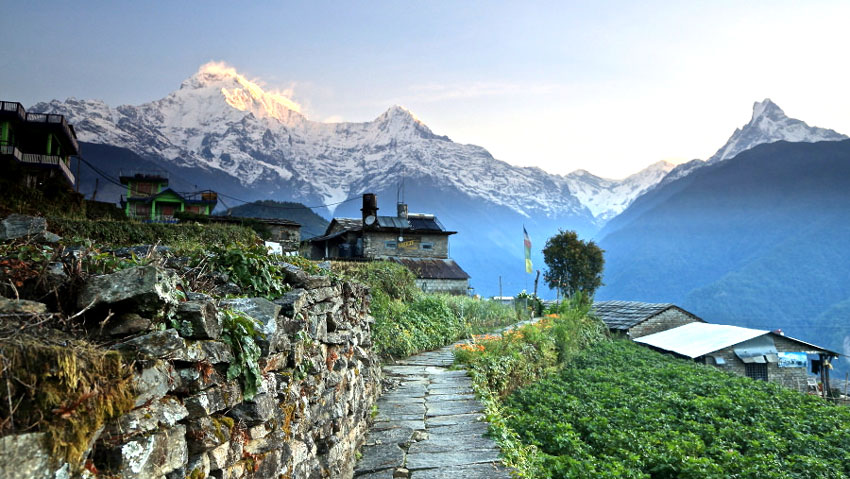
Breaking Down the Trek
- Nayapul to Tikhedhunga/Ulleri: This is usually the first segment of the trek, spanning about 10-12 kilometers. The trail starts relatively easy but becomes steeper as you approach Ulleri.
- Tikhedhunga/Ulleri to Ghorepani: Covering around 12-14 kilometers, this segment offers moderate trekking with some steep sections, especially as you get closer to Ghorepani.
- Ghorepani to Poonhill and then to Tadapani: This part covers about 15 kilometers. The early morning hike to Poonhill is short but steep, offering panoramic sunrise views. Afterward, the trek continues to Tadapani.
- Tadapani to Ghandruk: A distance of approximately 10 kilometers, this segment is relatively easier and more downhill.
- Ghandruk to Nayapul: Wrapping up the trek, this final segment covers about 10-12 kilometers, taking trekkers back to the starting point.
Safety and Pacing
- Know Your Limits: It's essential to understand your physical limits. Pacing yourself, taking adequate breaks, and ensuring you're well-hydrated and fed can make a difference.
- Acclimatization: While the Ghorepani Poonhill Trek doesn't reach extreme altitudes, it's still crucial to allow your body to acclimatize, especially if you're new to trekking or coming from sea level.
- Stay Informed: Listen to your guide and stay updated about the day's trekking duration and terrain. Foreknowledge helps in mental preparation.
- Choose a Comfortable Pace: Remember, trekking isn't a race. Choose a pace that lets you enjoy the scenery while also being mindful of your energy levels.
By understanding the total distance and preparing accordingly, trekkers can ensure a safer and more enjoyable experience. Luxury Holidays Nepal stands by every trekker, offering insights, support, and guidance throughout the journey. Every step you take is a step into the heart of the Himalayas, and knowing the distance makes the journey even more rewarding.
Train on Stairs up and Down
The Ghorepani Poonhill Trek, while being one of the more moderate treks in Nepal, still presents its fair share of uphill and downhill paths. For many trekkers, especially those who live in relatively flat areas, these gradients can be a challenge. A fantastic way to simulate the trek's demanding aspects and prepare oneself for the real experience is by training on stairs.
The Significance of Stair Training
- Muscle Preparation: Regular stair training strengthens the leg muscles – the quadriceps, hamstrings, calves, and glutes – which are extensively used during the trek.
- Endurance Build-Up: Climbing stairs repeatedly improves cardiovascular endurance, helping trekkers maintain stamina during prolonged uphill sections.
- Downhill Training: Descending stairs can be as challenging as ascending, especially on the knees. Training on stairs helps condition the body for the downhill sections of the trek.
- Balance and Coordination: Maneuvering up and down stairs enhances foot-eye coordination and balance, crucial for navigating uneven terrains.
Effective Stair Training Regimen
- Start Slow: Begin with a comfortable number of repetitions, steadily increasing as your stamina improves.
- Intervals: Alternate between walking and faster climbing. This interval training can simulate the varying paces on the actual trek.
- Weighted Training: Once you're comfortable, add a weighted backpack to simulate the load you'll be carrying during the trek. It aids in building strength and endurance.
- Downhill Focus: Don't neglect the descent. Practicing descending stairs can prevent knee injuries and improve joint flexibility.
- Consistency: Like all training, consistency is key. Incorporate stair training into your weekly routine, gradually increasing the duration and intensity as the trek date approaches.
Additional Tips
- Proper Footwear: Wear trekking shoes during stair training. It provides the right support and helps you get used to the shoes.
- Safety First: Always ensure the stairs are free of obstacles. Use handrails if needed, especially during the initial days of training.
- Stay Hydrated: Drink adequate water during training sessions to prevent muscle cramps and dehydration.
The Ghorepani Poonhill Trek is a rewarding experience, offering unparalleled views and cultural immersion. But, as with any adventure, preparation is crucial. Training on stairs up and down is an efficient way to equip oneself physically for the trek's demands. Our commitment is to ensure every trekker is well-prepared and safe, allowing them to fully savor the majestic beauty of the Himalayas. With each step on the stairs, you're one step closer to conquering the trails of Ghorepani Poonhill.
Checklists for Ghorepai Poon Hill Trek
Preparation is crucial for any trekking expedition, and having a comprehensive checklist ensures that you don’t leave anything behind. The Ghorepani Poon Hill Trek, with its mesmerizing vistas and unique terrains, offers an unforgettable experience. But to truly enjoy this journey and prioritize safety, trekkers must be well-equipped. Here is a detailed packing list to help you prepare for a secure trek to the Ghorepani Poon Hill Trek:
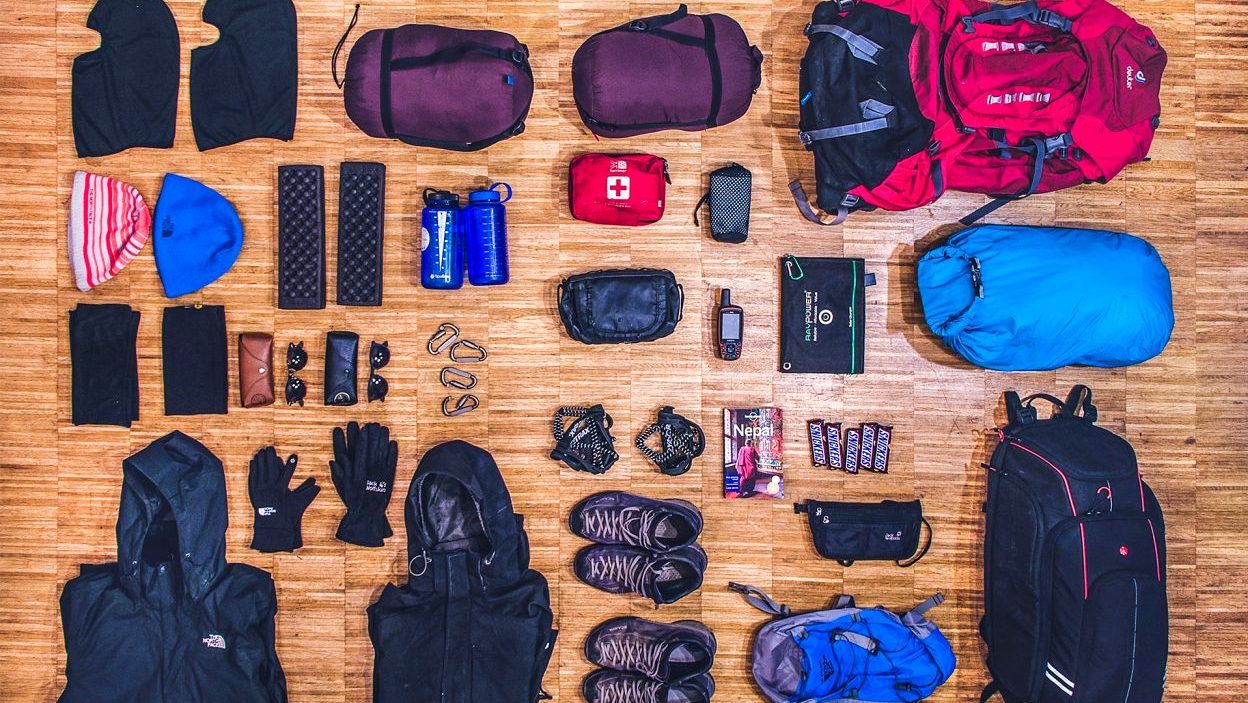
Trekking Gear and Equipment
- Backpack: A 40-50 liter backpack with adjustable straps and a rain cover.
- Sleeping Bag: For colder nights, especially at higher altitudes.
- Trekking Poles: Helpful for both ascent and descent, reducing pressure on knees.
- Water Bottles or Hydration Bladder: Ensure a minimum capacity of 2 liters.
- Headlamp with Extra Batteries: For early morning treks and power outages in teahouses.
- Sunglasses & Sun Hat: For sun protection.
- Gaiters: To prevent dust, mud, and snow from entering your shoes.
Clothing
- Base Layers: Lightweight and moisture-wicking materials.
- Trekking Shirts: Both short-sleeved and long-sleeved, preferably of moisture-wicking fabric.
- Trekking Trousers: Convertible ones can be beneficial.
- Fleece Jacket or Sweater: For colder temperatures.
- Insulated Jacket: Preferably down, for chilly evenings and mornings.
- Waterproof Jacket & Pants: For unpredictable rain showers.
- Underwear and Sports Bras: Comfortable for walking long distances.
- Warm Hat, Gloves, and Scarf: Essential for early mornings and higher altitudes.
- Trekking Boots: Well-broken-in, waterproof, and with good ankle support.
- Socks: Moisture-wicking and a few warmer ones for chilly nights
Health and Hygiene
- Personal Medical Kit: Include painkillers, antiseptic wipes, bandages, altitude sickness pills, and any personal medication.
- Water Purification Tablets or Filter: Essential to ensure you consume safe drinking water.
- Hand Sanitizer & Wet Wipes: For personal hygiene.
- Toilet Paper: Not always available in teahouses.
- Sunscreen & Lip Balm: With high SPF.
- Insect Repellent: Especially during warmer months.
- Toothbrush & Toothpaste: Small travel sizes are preferable.
Important Documents
- Passport: Always keep a photocopy separately.
- Trekking Permits: Like the TIMS card or any necessary Annapurna Conservation Area Permit.
- Insurance Details: Ensure it covers high-altitude trekking.
- Emergency Contact Information: Both local and international.
Being well-prepared can significantly enhance your Ghorepani Poonhill Trek experience. With this comprehensive checklist, Luxury Holidays Nepal aims to ensure trekkers are equipped for every scenario, allowing them to immerse themselves in the beauty of the trek with peace of mind. Remember, the Himalayas await, and with the right preparation, your journey will be both memorable and safe.
Ghorepani Poon Hill Heli Trek
The Ghorepani Poon Hill Trek is undoubtedly a highlight for many adventurers visiting Nepal. With its incredible vistas of the Annapurna and Dhaulagiri ranges and the immersive experience of the region's culture, it's a must-do for many. However, for those with limited time or seeking a more luxurious trekking experience, there's the option of a Heli Trek. The premium version of the trek provides its own unique set of safety considerations:
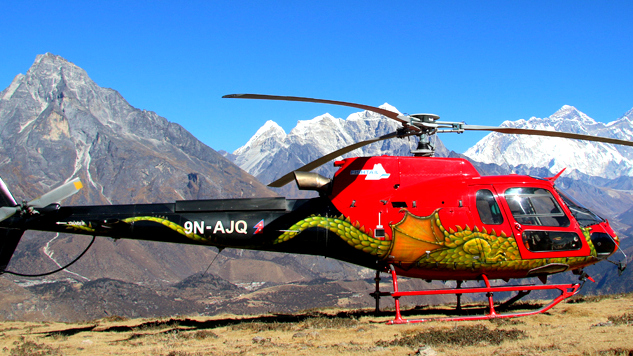
Why Consider a Heli Trek?
- Time-Efficiency: A Heli Trek can cut down on return time, allowing trekkers to explore more or relax post-trek.
- Aerial Views: Experience the majestic Himalayas from a unique aerial perspective, capturing panoramic vistas unavailable to ground-level trekkers.
- Physical Considerations: While the Ghorepani Poonhill Trek is moderate, a helicopter can provide relief for those with physical constraints, ensuring they don't miss out on the experience.
Safety Measures and Considerations
- Weather Conditions: Helicopters only operate under favorable weather conditions. Thick fog, strong winds, or heavy rain can lead to delays or cancellations. Always have a flexible itinerary.
- Altitude Awareness: Rapid ascents in a helicopter can cause altitude sickness. It’s essential to be aware of the symptoms and inform the pilot or guide if you feel unwell.
- Professional Pilots: Ensure that the helicopter service employs certified and experienced pilots familiar with the Himalayan terrain.
- Safety Briefings: Always pay attention to safety briefings before boarding. Understanding the safety equipment onboard, especially in the rare case of emergencies, is crucial.
- Weight Limitations: Helicopters have strict weight limitations, including passengers and their baggage. Adhere to these limits for safe operations.
Heli Trekking
- Departure: After completing the trek to Poonhill and soaking in the sunrise views, instead of retracing your steps, a helicopter can whisk you away from a nearby location.
- The Journey: As you soar above the terraced fields, dense forests, and isolated villages, the towering peaks of the Annapurna and Dhaulagiri ranges come into full view, offering photo opportunities like no other.
- Arrival: The helicopter will safely land in Pokhara, allowing you to continue with your journey or relax by the serene Phewa Lake.
Opting for a Heli Trek during your Ghorepani Poonhill adventure offers an exciting twist to the traditional trekking experience. By understanding the safety measures and what to expect, you can make an informed decision. Luxury Holidays Nepal is committed to ensuring that every aspect of your journey, whether on foot or in the air, is both safe and memorable.
Ghorepani Poon Hill Luxury Trek
When one imagines trekking in the Himalayas, the images that often come to mind include rustic teahouses, simple meals, and the elemental challenges of the trail. However, trekking doesn't have to be purely an endurance test. The Ghorepani Poonhill Trek transforms into an experience where comfort meets adventure, without compromising on safety. Let’s delve into the luxurious side of this iconic trek and understand how safety and indulgence can beautifully intertwine.
The Premium Stays
- High-Quality Teahouses and Lodges: While maintaining the traditional aesthetics, these establishments provide superior comfort, ensuring a good night's rest.
- Private Rooms: Forget shared dormitories; luxury trekking ensures private rooms, often with attached bathrooms and heated bedding.
- Gourmet Dining: Enjoy a fusion of local and international cuisines, prepared hygienically and with high-quality ingredients.
Enhanced Safety Protocols
- Smaller Groups: Luxury treks often cater to smaller groups, ensuring personalized attention and quicker response during emergencies.
- Superior Medical Kits: Expect advanced first aid kits, with provisions for more significant emergencies, including portable oxygen cylinders.
- Professional Guides: With luxury treks, you get experienced guides who not only know the trail but are also trained in guest hospitality and emergency response.
Additional Comforts
- Porter Assistance: Trek without the burden of a heavy backpack. Professional porters will handle your luggage, ensuring it reaches your next stop safely.
- Personalized Itineraries: Enjoy the freedom to set your pace, with flexible itineraries that cater to your preferences and physical abilities.
- Exclusive Experiences: Be it a private cultural performance, a guided village tour, or a spa day, luxury trekking is as much about the experiences off the trail as on it.
Responsible Luxury
- Eco-friendly Practices: Luxury doesn't mean wasteful. The accommodations and services prioritize eco-friendly and sustainable practices, ensuring that the beautiful Poonhill region remains pristine for generations to come.
- Supporting Local Communities: By opting for luxury services, you're directly supporting local enterprises, promoting sustainable tourism, and uplifting communities.
With the Ghorepani Poonhill Luxury Trek, you're not just embarking on a journey through the majestic Himalayas; you're indulging in a holistic experience that nourishes both the body and soul. Safety remains paramount but with added layers of comfort and exclusivity. We believe in offering the best of both worlds, ensuring your Himalayan trek is memorable, safe, and truly luxurious.
FAQs: Is it Safe to Trek to Ghorepani Poon Hill?
Q: Is the Ghorepani Poonhill Trek suitable for beginners?
A: Absolutely! This trek is considered moderate and is one of the more accessible routes in the Himalayas. It’s an excellent choice for beginners or those with limited trekking experience. However, it's always advisable to undertake some physical preparation before any trek.
Q: How do I prepare for altitude sickness?
A: The Ghorepani Poonhill Trek doesn’t ascend to extreme altitudes like some other Himalayan treks. However, you may still feel the effects of altitude. Ensure proper acclimatization, stay hydrated and walk at a comfortable pace. If you experience severe symptoms, it’s crucial to descend to a lower altitude and seek medical assistance.
Q: Are there medical facilities available on the trek?
A: While there are basic health posts and some pharmacies in the villages along the trail, it's essential to carry a personal first aid kit. In case of severe medical emergencies, evacuation can be arranged.
Q: What kind of accommodation can I expect?
A: Teahouses and lodges are the primary accommodation type on this trek. While they offer basic amenities, if you opt for a luxury trekking package, you can expect more comfortable lodgings with superior services.
Q: Is the water safe to drink during the trek?
A: It's advised not to drink tap water directly. Use water purification tablets, and filters, or boil the water before consumption. Bottled water is also available but consider the environmental impact.
Q: How challenging are the trails? Are they well-maintained?
A: The trails are generally well-trodden and maintained. However, like any mountain terrain, there might be rough patches or slippery sections, especially after rain. It's always advisable to wear sturdy trekking boots and use trekking poles for support.
Q: What safety measures are in place in case of unexpected weather changes?
A: Always check the weather forecast before starting the trek. Your guide will have experience in predicting weather changes and will advise on precautions. In case of severe weather, it may be necessary to adjust the itinerary, either by taking a rest day or altering the route.
Q: Are solo treks advisable?
A: While many solo travelers trek in the region, hiring a guide is recommended. Guides ensure safety, help in navigation, and can assist during emergencies. Additionally, they enrich the trekking experience with local insights and knowledge.
The following list includes the numerous trekking choices available in the Annapurna Region Trekking Packages
Ghorepani Poon Hill Trek - 10 Days
Ghorepani Poon Hill Sunrise Trek with Chitwan Jungle Safari - 12 Days
Annapurna in Luxury - 11 Days
Ghorepani Poon Hill Luxury Trekking with optional Chitwan Safari - 10 Days
Annapurna Circuit Trek - 17 Days
Annapurna Base Camp Heli Trek - 9 Days
Mardi Himal Trek - 12 Days
Annapurna Base Camp Trek - 10 Days
Annapurna Base Camp Trek - 15 Days
If you need any further information, please contact us by email: at [email protected], Phone: at +977- 985 100 5129 (WhatsApp)




